Opening of the Negotiations for Accession of the Republic of Serbia to the European Union




At the meeting of the European Council held on June 28, 2013 it was decided to launch the negotiations on Serbia’s accession to the European Union. The Council decided that the first Intergovernmental Conference, which is considered as the opening of the EU accession negotiations, would be held by the end of January 2014, at the latest. This was also the signal for intensifying preparations for the comprehensive multiannual negotiation process which will enable Serbia to become an EU member in the near future.
The upcoming European Union accession negotiations will lead to Serbia’s adjustment to the legal, economic and social system of the EU. The changes that this process will deliver represent a unique chance for Serbia to become a modern European state, to be an active partner in European affairs, and to use its reputation to protect and respect the rights of all its citizens to live on equal terms with other citizens of the European Union.
Expert collaboration: Government of the Republic of Serbia, Negotiating Team for Accession of the Republic of Serbia to the European Union, European Integration Office.
Artistic realization of the stamp: Jakša Vlahović, academic graphic artist.
Lunar horoscope - Year of the Horse



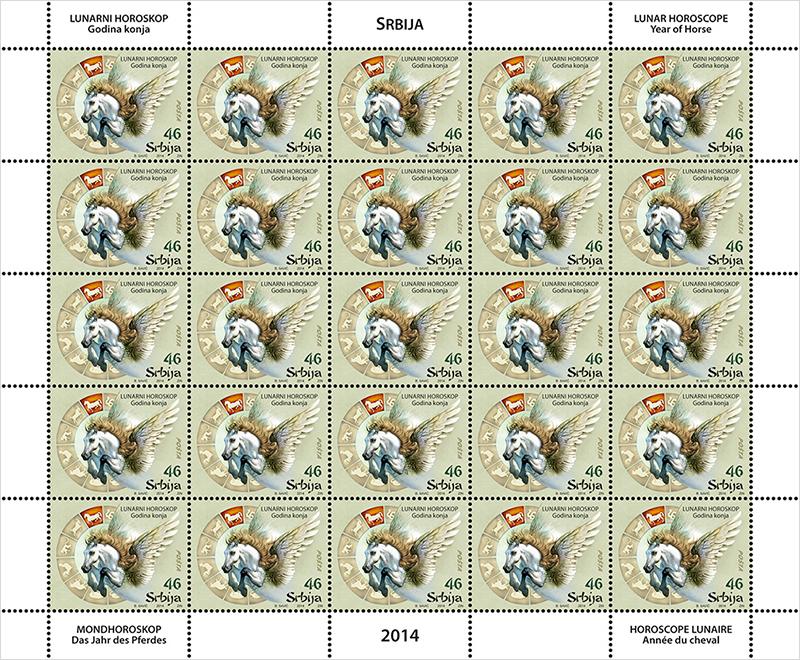
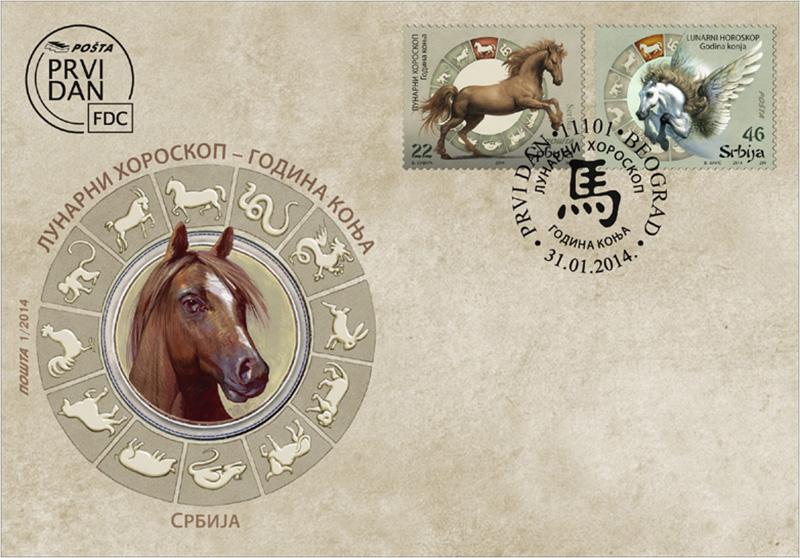

Chinese astrology is based on the traditional astronomy and calendars. It also has a close relation with Chinese philosophy (theory of the three harmony, heaven, earth and water) and principles: the wu xing teachings, yin and yang, five planets, the 10 Celestial stems, the 12 Earthly branches, the lunisolar calendar, etc.
The lunar calendar is based on cycles of the moon phase. Most lunar calendars are in fact lunisolar calendars. That is, months are kept on a lunar cycle, but then intercalary months are added to bring the lunar cycles into synchronisation with the solar year. Chinese, Hebrew, and Hindu calendars are lunisolar, as well as most calendar systems used in antiquity. Lunar calendars differ as to which day is the first day of the month. For some lunar calendars, such as the Chinese calendar, the first day of a month is the day when an astronomical new moon appears in a particular time zone.
The Chinese horoscope falls into the oldest known horoscopes. It consists of 12 signs of which each one rules over a lunar year. These Zodiac signs have the names of animals (Rat, Ox, Tiger, Rabbit, Dragon, Snake, Horse, Sheep, Monkey, Rooster, Dog and Wild Boar). In the Chinese horoscope, besides basic signs, very important are also elements: Wood, Metal, Water, Fire and Earth. Every person born in the year of the assigned animal is said to have personalities and traits resembling that animal.
The year 2014, as the Year of the Horse covers the period from 31st January 2014. to 28th February 2015. The 2014. is the Year of the Wood Horse. The last Year of the Horse was in 1954. as the repetition cycle of the same combination of sign and element occurs every 60 years. The Year of the Horse occurs every 12 years but the Year of the Wood Horse every 60 years.
That’s why all the people born in 1954, 1966, 1978, 1990, 2002 should work on what they really want, because in 2014. it will be easier to accomplish than usual.
General characteristics of people born under the sign of the Horse are: activity, energy, independence, freedom-loving, have style and good taste, give all for love. Patience is not their strong suit. He wants to wildly gallop towards the obstacles, without looking neither left nor right. The Wood Horse is as volatile as the other Horse, but it has better control, and better sense of discipline and is ready for reasonable discussion.
Artistic realization of the stamps: Boban Savić, М.А, academic painter.
XXII Olympic Winter Games in Sochi 2014






XXII Winter Olympic Games will take place in Sochi, Russia from 7 to 23 February 2014. 98 events in 15 winter sport disciplines and 7 sports will be held. Official slogan “Hot.Cool.Yours.” reflects national character of Russia and the values of the Sochi 2014. The Olympic Winter Games mascots are Polar Bear, European Hare and Amur Leopard.
Total of 12 new events are contested to make it the largest Winter Olympics to date: One of the most anticipated events is snowboard slopestyle (men and women), ski slopestyle (men and women), ski half-pipe (men and women), biathlon mixed relay, figure skating team event, women’s ski jumping, luge team relay, snowboard parallel special slalom (men and women).
It was the longest torch relay in Olympic history, carried by 14.000 people from all around and the torch travelled more than 4 months towards 2900 cities and places.
Olympic Team of Serbia consist of 8 athletes in 5 sports: Nevena Ignjatovic and Marko Vukićević (alpine skiing), Ivana Kovačević, Rejhan Smrković and Milanko Petrovic (cross-country), Milanko Petrović (biathlon), Nina Micić (snowboard), Vuk Rađenović and Aleksandar Bundalo (bobsleigh).
Artistic realization of the stamps: Nadežda Skočajić, academic painter - graphic artist.
Expert collaboration: Olympic Committee of Serbia.
Easter






Easter Sunday is the date of the annual celebration of Christ’s resurrection. The Orthodox Church celebrates the Easter on the basis of the Julian calendar. The date is not fixed, but denotes the same season of the year and the same relationship to the preceding astronomical full moon that occurred at the time of His resurrection in 30 A.D. Easter is one of the most important Christian holidays. This is a day of eternal joy, the day when Christ, the Son of God, conquered the death. By the act of resurrection Jesus Christ proved his divine power and opened the gate of eternal life, joy and happiness that we can find in our faith.
On Easter Sunday morning the church bells toll, and the people, together with their priest, go around the church. After the third round they stand in front of the church door. The priest carries the cross, candle and the censer and chants the Easter hymn. The door open and they enter the church where liturgy continues. When it ends, people greet each other with the words: “The Christ has resurrected”, and “Indeed he has”. There are many customs connected with Easter Sunday, and certainly one of them that children like best, is colouring and offering of eggs. The first egg is coloured red and in many parts of our country it is called “The house keeper” and is kept for the whole year, until the next Easter.
Motif on the stamp of nominal value 22.00 RSD: “Last Supper”. Motif on the stamp of nominal value 46.00 RSD: “Entombment of Christ”. Motif on the envelope: “Students’ Cross”. Icons and “Students’ Cross” are works of Pavle Simić from the Church of the Transfer of Relics of St. Father Nicholas, 1866-67.
Graphic realization of the stamps: MA Jakša Vlahović, academic graphic artist.
Professional Cooperation: Serbian Orthodox Church, Eparchy of Banat.
Art










150 years since the birth of Branislav Nušić
Branislav Nušić (Belgrade, 20th October 1864 – Belgrade, 19th January 1938), a comedy writer, playwright, novelist, essayist and founder of modern rhetoric in Serbia and outstanding amateur photographer. Also worked as a journalist and a diplomat. Renowned for his remarkable humour, he wrote about people and their characters. He was born in Belgrade, in the house where today stands the building of the National Bank of Serbia, as Alkibijad Nuša, in Aromanian family of Đorđe and Ljubica Nuša.
He attended elementary school in Smederevo and the first two grades of boarding school, but he graduated from boarding school in Belgrade. Upon turning 18 years of age, he legally changed his name to Branislav Nušić. In 1885, he graduated from the University of Belgrade’s Law School. He became a civil servant in 1889. As an official of the Ministry of Foreign Affairs he was appointed to clerk the consulate in the city of Bitola. He got married in1893 to Darinka, daughter of merchant Božidar and Ljubica Đorđević. He spent a whole decade in the southern Serbia and Macedonia. During his service as Vice-consul in Priština, he left his testimony on suffering of the Serbian people in his work Consul’s Letters. In his vivid career, Nušić was a Secretary in the Ministry of Education, a playwright in the National Theatre in Belgrade, and in 1902 he was appointed as a postal and telegraph commissioner of the first grade in the Ministry of Construction, Postal and Telegraph Department. Also, he was the manager of the Serbian National Theater in Novi Sad, and he founded the theatre in Skopje, where he used to live till 1915. He spent the First World War in exile in Italy, Switzerland and France. After the war, Nušić was appointed as the first manager of the art department of the Ministry of Education, and in 1923 he was appointed the manager of the National Theatre in Sarajevo. In 1927 he returned to Belgrade. He was elected a regular member of the Serbian Royal Academy on 10th February 1933. He died on 19th January 1938, and on that day the facade of the Belgrade National Theatre was wrapped in black canvas. Based on his turbulent life a TV drama was recorded, called Frivolous Branislav Nušić, 1986.
Apart from his name, he published under the alias Ben Akiba, and his most popular works were as follows: dramas: It Had to Be This Way, High Seas, Rental Fee; comedies: Favoritism, The World, A Trip Around the World, The Cabinet Minister’s Wife, The Parliamentarian, Mister Dollar, Bereaved Family, The Deceased, A Suspect Individual, Doctor, Authority (unfinished); novels: County’s Child, Hajducs, 915th, Autobiography; short stories: Political Rival, Eulogy, Class, Tales of a Corporal; tragedies: Knez Ivo of Semberia, Hadzi-Loya, Foundling.
200 years since the birth of Mikhail Lermontov
Mikhail Yuryevich Lermontov (Moscow, October 3 1814 – Pyatigorsk, July 15 1841) was a Russian Romantic writer and poet, known as “the poet of the Caucasus”. Lermontov was born in Moscow, but he grew up in the village of Tarkhany, where his tomb is today. His family is descended from the Scottish family of Learmunt, that moved to Russia in the early 17th century. His grandmother, who raised him because his mother died young and his father was in the army, maid sure that Lermontov got the best schooling.
After finishing high school, Lermontov enrolled into the Moscow University in 1830, but he didn’t stay there long because of his disobedience to a professor. From 1830 till 1834 he attended the military school in Sankt Petersburg, where he became an officer. During that time he wrote a lot of poetry under the influence of Pushkin and Byron. He also took interest in Russian history and medieval epics, which was reflected in The Song of the Merchant Kalashnikov, his long poem Borodino and a series of popular ballads. After the death of Pushkin, in 1837, Lermontov expressed his feelings in his poem addressed to Tsar Nikolai I Pavlovich, demanding the revenge against Pushkin’s murderer. The poem accused the “pillars” of Russian high society for Pushkin’s death. Because of this poem, Nikolai I Pavlovich banished him to Caucasus, where Lermontov had lived before as a boy. He visited Sankt Petersburg in 1838 and in 1839. His doomed love for Varvara Lopukhina was recorded in his unfinished novel Princess Ligovskaya. After the duel with the son of the French ambassador, he was sent back to the army in Caucasus. In 1839 he finished his only novel, A Hero of Our Time, which practically predicted a duel in which Lermontov lost his life two years later.
450 years from the birth of William Shakespeare
William Shakespeare (1564-1616) was the greatest writer and dramatist in the english language. His extant works, including some collaborations consist of about 38 plays, 154 sonnets and few poems. His plays have been translated into every major living language and are performed around the world more often than those of any other playwright. Shakespeare was born and brought up in Stratford-upon-Avon. At the age of 18 he married Anne Hathaway with whom he had three children.He had a successful career in London as an actor, writer, and part-owner of a playing company called the “Lord Chamberlain’s Men“ later known as the “King’s men”. With several actors from the troupe he founded his own theater Globe in 1599. He returned to Stratford around 1613 where he died three years later.
Shakespeare wrote mostly comedies and historical dramas till 1950, which he rose to perfection. The first comedy double plots and clear comic sequences (Midsummer Night’s Dream and The Merchant of Venice) was preceded by his best works of this genre - Much Ado About Nothing, As You Like It, Twelfth Night. His first tragedy, Romeo and Juliet, published 1595th and this segment of his oeuvre, which is called his “tragic period” ended the 1599th with Julius Caesar. During this period they are incurred Hamlet, King Lear and Macbeth, theater pieces that are among the best ever written in the English language. Since 1608th to 1613th Shakespeare wrote the tragicomedy (romance). The first recorded work was written in the early nineties of 16th century are Richard III and Henry VI. Although it is very difficult to determine the exact date when Shakespeare’s plays incurred, experts believe that Titus Andronicus, Comedy of misunderstanding, The Taming of the Shrew and Two noblemen from Verona also belong to this period.
Shakespeare was a respected poet and playwright during his life, but his reputation did not rise to its present heights until the 19th century. The Romantics, in particular acclaimed Shakespeare’s genius, and the Victorians worshipped Shakespeare with a reverence like idol. In the 20th century his plays are constantly performed in diverse cultural and political contexts throughout the world. Besides the above mentioned, he wrote the tragedies: Troilus and Cressida, Othello, Antony and Cleopatra, Coriolanus, Timon of Athens; comedies: Love’s Labour’s Lost, Merry Wives of Windsor, All’s well that ends well, Measure for measure, Pericles,Prince of Tyre, Cymbeline, Winter’s tale, Tempest, historical dramas: King Richard II, King John, King Henry IV, King Henry V, King Henry VIII; songs: Sonnets, Venus and Adonis, The Rape of Lucrece, The Passionate pilgrim.
Artistic realization of the stamp: MA Marina Kalezić, academic painter.
Еurope – national musical instruments






Musical instrument is an important element of the musical tradition of a nation. Musical instruments take numerous forms, and by their origin they can be indigenous or adopted from another culture, but can also become national beacause of its use.
According to classification of musical instruments of Germam ethnomusicologists Curt Sachs and Erich M. Hornbostel, which takes as the criterion any material as the source of the sound and the way the sound is produced by these instruments, musical instruments can be divided into four groups, namely: 1. Idiophones; 2. Membarnophones; 3. Chordphones and 4. Аеrophones.
In Serbian traditional practice idiophone (self-sounding) instruments are relatively rare and their structure is usually relatively simple. Their function ranges from ritual via signal to literally musical (bell, clapper, jew’s harp).
Membranophone instruments (producing sound by a vibrating membrane) are relatively rare, and are characteristic by their musical function (drum/tapan, darbuka, tambourine i.e. def, cupa or begesh). Chordphone (string) instruments produce sounds by plucking (striking) or by dragging a bow between two stretched fixed points (tambura, tambura ensemble, gusle (single-string fiddle), gusle ensemble). Aerophone (aer–air, greek) instruments can be: free (leaf, grass and onion feather) and wind instruments. Wind instruments in Serbia are undoubtedly the most numerous and are present in almost all existing groups, such as labial/ folk flutes (fife-duduk-flute, ocarine, twin pipes, cevara (pipe instrument)); fifes played with tongue/folk clarinets (leika, zurle, bagpipes, diple), and fifes that produce sounds by vibration of lips/trumpet (tree bark trumpet, rikalo-punched, wind–brass orchestra).
Fife/duduk/flute belongs to the family of so-called folk flutes. It is made of wood and has six holes for playing. It can be made in more sizes. Sound produced by the longest instruments is often “boosted” by a characteristic tone coming out of player’s throat.
Bagpipes belong to so-called folk clarinets since the source of their sound is a beep through a single reed. In musical practice in Serbia there are two types of bagpipes: two-voiced bagpipes (southern Morava-Macedonian and Vlach) and three-voiced bagpipes (Svrljig and Banat bagpipes).
Artistic realization of the stamps: Nadežda Skočajić, academic painter - graphic artist. Expert collaboration: Dr. Dimitrije O. Golemović.
European nature protection






Institute for Nature Conservation of Serbia nominated natural resources Nature Park „Stara Planina“ and landscape Zaovine for the World Network of Biosphere Reserves under the UNESCO program „Man and Biosphere“ (MAB) ,due to their natural resources.
Nature park “Stara Planina” recognizable by its diverse geological structure with dominant rocks of red sandstone with a developed specific world of flora and fauna is located in eastern Serbia. The landscape of the Park is dominated by slightly wavy plateau pastures intersected by streams which often turn to rapids and cascading and waterfall fractions. The diversity of wild flora and fauna is featured by the presence of 1200 species and sub-species of higher plants, approximately 200 species of birds, 30 species of mammals, 13 species of reptiles and 26 species of fish. Cultural and historic features of the area include monumental medieval heritage dating back from the period of Branković. Based on the Institute’s Conservation Study, Stara Planina was proclaimed a Nature Park in the total area of 114,332 hectares, as a Category I natural resource of great importance. This proclamation established the largest natural resource in Serbia which was also proposed for conservation at the global level as the Biosphere reserve (UNESCO, MaB).
Lanscape Zaovine is located in western Serbia, on the southern slopes of Tara mountain in forested highland area. Zaovine is particularly famous as the site where Josif Pančić, in 1875, discovered spruce (Picea omorika), a living fossil of flora. This area has 55 species on the Preliminary Red List of the Flora of Serbia and 25 plant species of international importance, 108 species of birds, 14 species of fish, 6 species of amphibians, 5 species of reptiles and 36 species of mammals. The most significant representative of insects is the relic and endemic species of Pančić’s grasshopper (Pyrgomorphulla serbica). In its Conservation Study the institute valorised Zaovine in the area of approximately 6.300 hectares (settlement Zaovine, four lakes and Beli Rzav canyon), which shall be protected within National Park “Tara” and thus proposed for conservation at the global level as a part of a transboundary biosphere reserve “Drina”, which includes part of the territory of Serbia and Republika Srpska in Bosnia and Herzegovina (UNESCO, MAB).
Artistic realization of the stamps: Miroslav Nikolić
Expert collaboration: Institute for Nature Conservation of Serbia
First World War - the Centenary







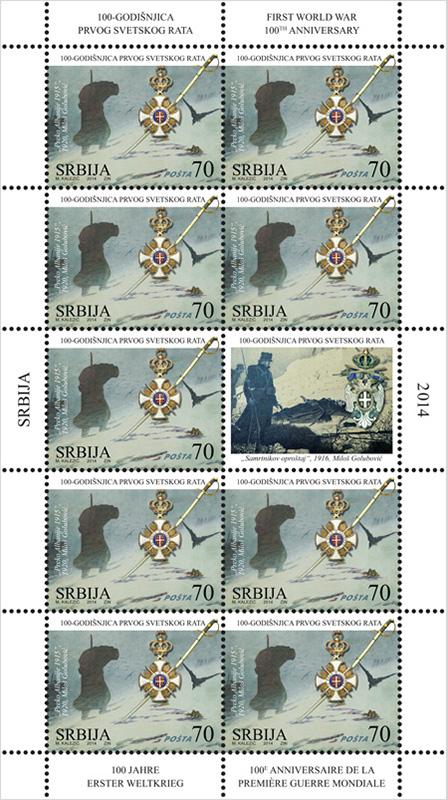
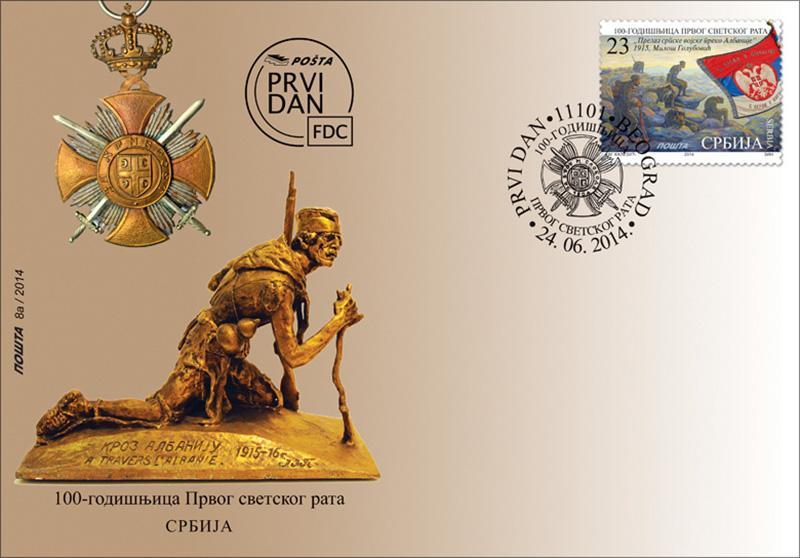

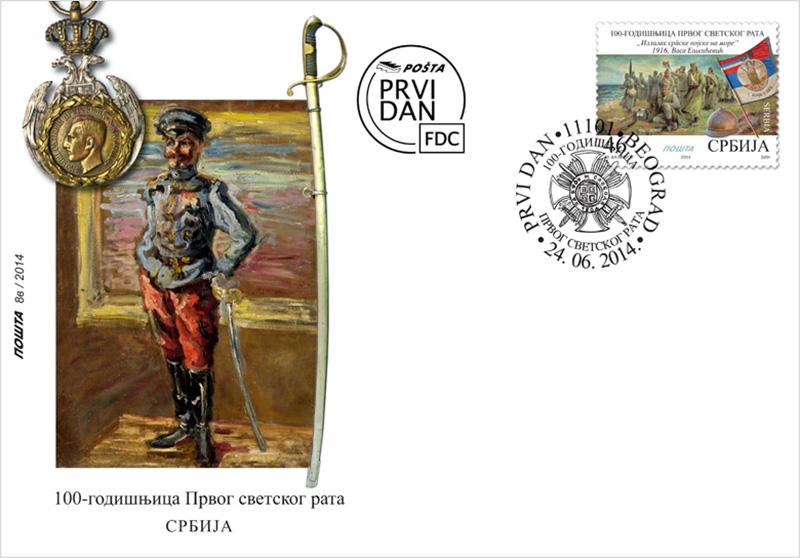

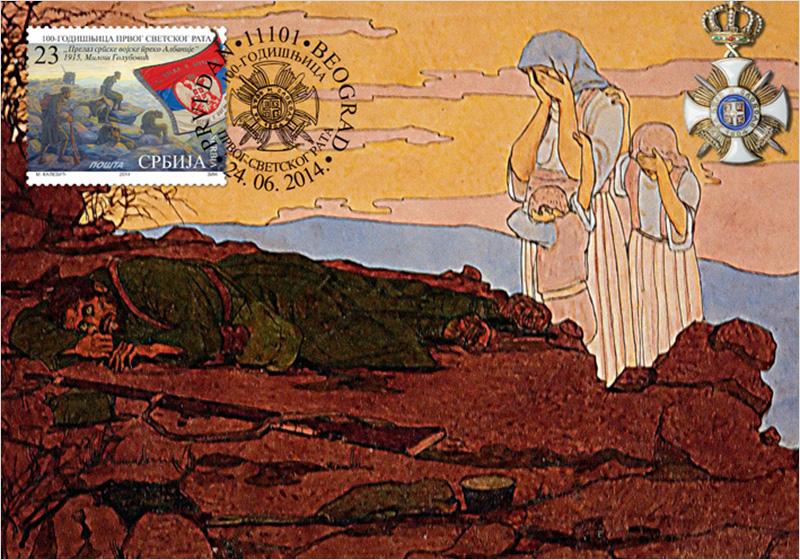




The trigger that started the First World War was the assassination of Archduke Franz Ferdinand, the heir to the Austro-Hungarian throne, on 28th June 1914 in Sarajevo. The war ended in 1918; some 65 to 70 million people from 36 countries were mobilised, most of those called to arms being from Europe. The Entente Powers, gathered around the United Kingdom, Russia and France, waged war against the Central Powers lead by Austro-Hungary and Germany. In one of the most gruesome confrontations in the history of the human race, more than ten million people died and twenty million more were wounded; the Kingdom of Serbia lost to the war more than a million of its citizens - 370,000 of them under the arms (26%).
Serbia was the very first country under attack. The Austro-Hungarian offensive in 1914 ended miserably with a tremendous defeat of the imperial army in the battles of Cer, Kolubara and Drina. The Serbian army was headed by Prince Alexander Karageorgevitch, the Supreme Commander, and marshalls (“vojvodas”) and generals Živojin Mišić, Stepa Stepanović, Radomir Putnik, Petar Bojović and Pavle Jurišić-Sturm. After initial victories, the Serbian army was forced to retreat to Albania and further to Greece, together with the Serbian King Peter I and Nikola Pašić, the Prime Minister, under the massive Austro-Hungarian onslaught in 1915. The survivors recovered in the Allies’ military hospitals in the Corfu island and Salonica, Greece, and Bizerta, Tunisia. In the autumn of 1916, the Serbian army achieved a great victory in the battle against the Bulgarian army at Kajmakčalan, and two years later, together with the Allies, launched an offensive to break through the Macedonian Front.
The war ended by the Treaty of Versailles on 20th June 1919, with a new territorial recomposition of Europe as the consequence. Germany lost its colonies, and on the ruins of the Austro-Hungarian and the Ottoman Empires new countries were born: Austria, Hungary, Czechoslovakia, and, thanks to the victories on the battlefield and diplomatic skills, the Kingdom of Serbs, Croats and Slovenes. The territories of the Ottoman Empire outside Anatolia were assigned to the Entente Powers as protectorates, whereas the core territory of the Empire was reorganised into the Republic of Turkey. The Russian Empire, leaving the war after the October Revolution in 1917, ceded large parts of its territory to newly-emerging European countries: Finland, Estonia, Latvia, Lithuania and Poland.
The motifs of the stamps, First Day Covers, maximum cards and the text were done in collaboration with the Serbian Academy of Sciences and Arts, Military Museum in Belgrade, Museum of Contemporary Art in Belgrade and PTT Museum in Belgrade.
Мотив на марки номинале 23,00 дин: „Прелаз српске војске преко Албаније”, 1915, уље на платну, аутор Милош Голубовић; збирка ПТТ музеја у Београду; пуковска застава из збирке Војног музеја у Београду; Мотив на вињети:„Из рата”, 1915/1916, туш, акварел,/папир, аутор Милош Голубовић; збирка Музеја савремене уметности у Београду; орден Карађорђеве звезде са мачевима IV степена из збирке Војног музеја у Београду;Мотив на коверти:„Прелаз српске војске преко Албаније”, скулптура, аутор Јован Пешић, збирка ПТТ музеја у Београду; војнички орден Карађорђеве звезде са мачевима из збирке Војног музеја у Београду.
Motif on the stamp face value 23,00 RSD: “Crossing of the Serbian army through Albania“, 1915, oil on canvas, author Miloš Golubović; collection of the PTT Museum in Belgrade; regiment flag from the collection of the Military Museum in Belgrade; Motif on the vignette: “From the war“, 1915 / 1916, ink, watercolor / paper, author Miloš Golubović; collection of the Museum of Applied Arts in Belgrade; Order of the Star with Swords of Karađorđe of the IV degree from the collection of the Military Museum in Belgrade; Motif on the envelope: “Crossing of the Serbian army through Albania“, sculpture by Jovan Pešić, collection of the PTT Museum in Belgrade; Order of the Star with Swords of Karađorđe from the collection of the Military Museum in Belgrade.
Motif on the stamp face value 46,00 RSD: “Arriving of the Serbian army to the sea“, 1916, oil painting, author Vasa Eškićević; property of ATP “Lasta“, Belgrade; regimental flag and Serbian helmet type Adrian, from the collection of the Military Museum in Belgrade; Motif on the vignette: “Vizier’s bridge“, 1915, oil, pastel and watercolor, author Vladimir Becić and silver medal for bravery, collection of the Military Museum in Belgrade; Motif on the envelope: “Officer“, 1914, oil / cardboard, author Nadežda Petrović, collection of the Museum of Contemporary Art in Belgrade; Albanian medal and infantry officer’s sword, collection of the Military Museum in Belgrade.
Motif on the stamp face value 70,00 RSD: “Through Albania 1915“, 1920, oil / canvas, author Miloš Golubović; Order of the Star with Swords of Karađorđe of the III degree and infantry officer’s sword from the collection of the Military Museum in Belgrade; Motif on the vignette: “Dying man’s farewell“, 1916, ink / paper, author Miloš Golubović and Order of White Eagle with Swards of the IV degree, collection of the Military Museum in Belgrade; Motif on the envelope: “Cannoneer“ 1914, oil / cardboard / hardboard, author Nadežda Petrović, Museum of Contemporary Art in Belgrade; Order of White Eagle with Swords of the IV degree and silver wreath awarded to the flag of the 13th infantry regiment “Hajduk Veljko“, collection of the Military Museum in Belgrade.
Motifs on the maximum cards: “Good-bye, my children”, 1915 / 1916, ink, watercolor / paper, author Miloš Golubović, collection of the Museum of Contemporary Art in Belgrade; Order of the Star with Swords of Karađorđe of the IV degree from the collection of the Military Museum in Belgrade. “Landscape of Corfu”, 1v918, oil / cardboard, author Kosta Miličević, collection of the Museum of Contemporary Art in Belgrade; regimental flag and infantry officer’s swords from the Military Museum in Belgrade. “Corfu Church”, 1918, oil / cardboard, author Kosta Miličević, collection from the Museum of Contemporary Art in Belgrade; war medal for the liberation and unification of 1914 - 1918, from the collection of the Military Museum in Belgrade. “Belgrade (View of the river Sava and the collapsed bridge)”, 1914, oil / canvas, author Natalija Cvetković, collection from the Museum of Contemporary Art in Belgrade; flag, gift of the women from Požarevac, dedicated to the liberators in 1918. and Order of the Star with Swords of Karađorđe, from the collection of the Military Museum in Belgrade.
Graphic realization of the stamps: MA Marina Kalezić, academic painter
Fauna








Wild Cat Felis Silvestris – The wild cat is the smallest European representative of cats. Though it is often thought that the domestic cat has resulted from taming thereof, it is completely wrong because the domestic cat origins from the early tamed North-American cats and proofs thereto have been found in the remainders of the ancient Egyptian culture. Nevertheless, given that the word is about related types, hybridisation of the domestic and wild cat occurs very often nowadays because domestic cats are more and more numerous in the nature as the feral ones. The wild cat is a typical forest type of mammals which more difficultly gets accustomed to the vicinity of the man using more often hidden places of some abandoned buildings out of settlements, as their burrows. They bring forth up to 4 youngs and live in much hidden way. They feed with birds and small mammals which they catch very skilfully. The wild cat is classified into protected types which are protected in Serbia by a hunting-closed-season as from 1st March till 30th June, whereas in Vojvodina it is strictly protected and the hunting-closed-season is prescribed throughout the whole year.
Fox Vulpes Vulpes – For the hunters it is a pest, for the naturalists an industrious sanitary worker. The fox belongs to the family of dogs and order of beasts and as such it is the most numerous among them. Its primeval habitation is forest, but it has adjusted to the life in the vicinity of the man because close to him it more easily comes to abundance of food. They live in burrows they find or they dig by themselves. They do not form packs but only aggregations which are created by usage of common shelter. In the brood there may be about 7 youngs. The fox has long time ago, in search of food, started living immediately close to the man, especially because of eatable organic waste the man piles up in his environment, but also because of availability of cattle, particularly of poultry. As rarely as any other type, but based on its biology, large number and ecological role in the nature, the fox in Serbia has not been classified in the lists of protected types for a long time, and especially it has not been protected by a hunting-closed-season. Although it has recently got such status, however, it may be hunted during the whole year. It is a main reservoir and transmitter of rabies in the nature. Because of that, in Serbia recently has started application of oral vaccination in the nature against this dangerous zoonosis.
Wolf Canis lupus - It is the greatest representative of the family of dogs in Europe. Lives in packs where there is precisely defined hierarchy all the members stick to, which is reflected in existence of a dominant couple and their followers of different levels, common hunting, sequence of feeding and other manifestations. They are brought forth in burrows and there could be 6 youngs in one brood. Settlement of wolves is usually in the forests of hilly terrains and mountains which offer sufficient places for hiding. Their food is meat and offals, first of all those of mammals. Their preys are members of the most available types, but their favourites are the Ungulata – the roe-deer and deer and they gladly eat carcasses. They regularly make damage to the domestic animals if they are enabled by a traditional way of keeping and holding cattle. That’s why the wolf is disliked among village inhabitants, particularly among cattle breeders. Due to that reason they often become a target of hunters, although hunting of wolves is not that simple and often, because the wolf is a master of avoiding the man and his chases. After the Second World War population of wolves in Serbia was significantly reduced in number because of use of poisonous bites. After the usage of poison had been forbidden, the population has gradually recovered and nowadays in Serbia there live about 1000 specimens. Males may be hunted during the whole year and females and youngs as from 1st July till 28th February. In Vojvodina, it is strictly protected in some parts of the province.
Lynx Lynx Lynx - This is the biggest European cat. It lives a hidden life in hardly accessible hilly and mountain forests, especially those ones that are rich in pastures, clearings and rocks. The lynx is a loner and more specimens may be seen only in the period of copulation and during the period of growing-up of youngs when they, with their mother, make a family group. They copulate in February; bring forth up to four youngs in April and the youngs leave their mother a little while after a year of age. They eat meat of available mammals and birds and their most often preys are roe-deer, wood hens and chamois. In Serbia, cases of damage caused by lynx are almost unknown. In many countries the lynx is permanently protected type and only in some countries it is protected by a hunting-closed-season. In Serbia, the lynx has been permanently protected for a long time and is classified within the strictly protected types. In the South-Western parts of the country there live members of the Balkans population which is likely to lose the battle with time and man and is on the brink of survival. In the Eastern parts of Serbia there live members of the Carpathian Mountains population perspective of which is bright because their areal and number are increasing.
Artistic realization of the stamps: Boban Savić М.A., academic painter.
Expert collaboration: Museum of Natural History in Belgrade.
Joy of Europe




Every year since 1969, the children’s meetings named Joy of Europe gather together European children aged between 7 and 15, promoting friendship through various activities as a symbol of united children’s world, but also representing a constant exchange of different culture backgrounds. Every October (from 2nd to 5th Oct.), the authentic children’s creativity demonstrated in close contact with citizens of Belgrade, opens up to better interpersonal understanding and better understanding of children’s world on the whole.
For 40 years now, the Children’s Cultural Centre Belgrade organises the children art competition Joy of Europe, and the works of the most talented children from Europe and the world find their place on the special issue stamps and envelopes of the first day of the Post of Serbia.
Motive on the stamp: K. Banuchander, 10 years, India.
Motive on vignette: A. Sandeep Kumar, 18 years, India.
Motives on the envelope: Andrea Tomović, Serbia; Mateusz Prewdzing, 11 years, Poland; Matilda Milisavljević, 11 years, Serbia; Krutarth Shah, 6 years, India.
Expert assistance: Children’s cultural centre Belgrade.
Graphic processing of stamp: Anamari Banjac, academic painter.
100 Years since the Birth of Serbian Patriarch Pavle
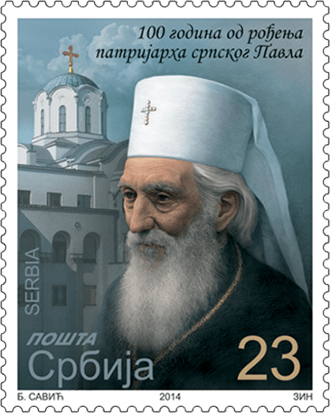

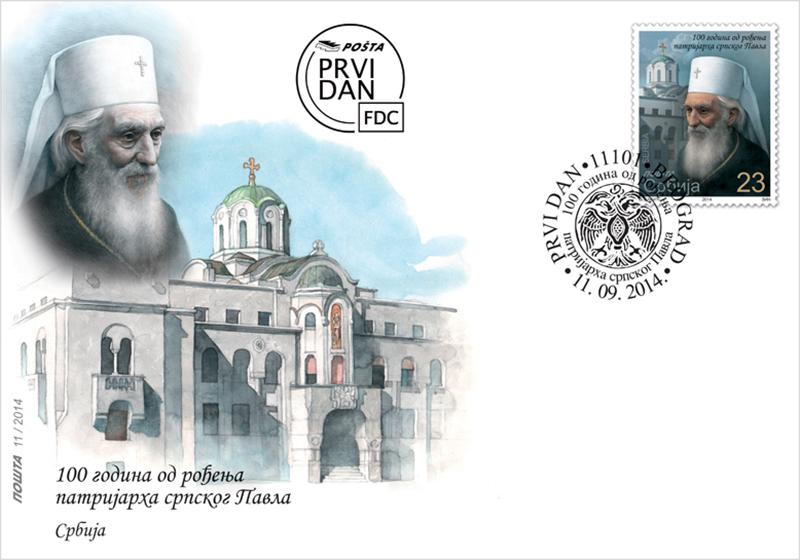

Patriarch Pavle (Gojko Stojčević at baptism) was born on 11 September 1914 (on the Beheading Day) in the village of Kućanci, district of Donji Miholjac in Slavonia (modern Croatia) to peasant parents. He finished elementary school in the place of birth, junior school in Tuzla and grammar school with the graduation exam at the VI Boys’ Grammar School in Belgrade. He finished the 6-year High School of Theology in Sarajevo in 1936 and graduated from the Faculty of Orthodox Theology in Belgrade.
At the breakout of the Second World War he was a conscript. As a refugee, he stayed at the Holy Trinity Monastery in Ovčar. During the years of foreign occupation he was a religious teacher to refugee children in Banja Koviljača till 1944. Then he fell ill and retreated to the Vujan Monastery, where he stayed until 1946. Two years later he moved to the Annunciation Monastery in the Gorge of Ovčar and Kablar. Between 1949 and 1955 he was at brotherly service of the Rača Monastery performing various duties. Meanwhile, he spent one academic year 1950/51 as a supply teacher at the High School of Theology in Prizren, precisely when the first post-war generation reached the graduation exam. At the Annunciation Monastery he took monastic vows in 1948. The same year he was ordained as hierodeacon and in 1954 as hieromonk.
He was awarded the rank of protosingel in 1954. From the Christmas of 1955 till May 1957 he was a post-graduate student in Athens. While in Greece he particularly focused on the studies of the New Testament and Liturgical issues, which was extremely useful to him in his later engagement in the publication of numerous liturgical texts in the Church Slavonic and Serbian language. He was elected as the Bishop of Raška and Prizren on 29 May 1957. He was enthroned on 13 October 1957 at the Cathedral Church of Prizren. For his patient and reliable scientific theological work, the Faculty of Theology awarded him the title of an Honorary Doctor of Theology in 1988.
On 1 December 1990 Bishop Pavle was elected as the Patriarch of the Serbian Orthodox Church. The newly elected Archbishop of Peć, Metropolitan of Belgrade and Karlovci and Serbian Patriarch Pavle was enthroned the next day, on 2 December at the Cathedral Church in Belgrade. In his inauguration speech the new Patriarch addressed a message of peace and love to the Serbian Orthodox believers, the Orthodox Universe, the Christian world and all the people of good will. At the Monastery of the Peć Patriarchate, he was enthroned as a Patriarch of Peć on 22 May 1994. He passed away at the Military Medical Academy in Belgrade on 15 November 2009.
Artistic realization of the stamps: Boban Savić, М.А, academic painter.
Stamp Day




Letter as a witness of time
The emergence of writing gave rise to the need for a written word to be transmitted. Ancient Romans were particularly concerned when it came to delivering mail across their Empire. The word mail (posta, poste, post) derives from a Latin verb ponere, meaning to place or put. While the Latin meaning of this word signified the concept of the site of a travel station served for changing horses and a place for harbingers to rest, today it has become almost a universal term that encompasses the entire mailing facility with all of its many functions.
A letter is form of written communication between people, a communication between the sender and receiver, who are spatially separated. It serves to convey thoughts, desires, feelings, as well as information and messages. The function of letter writing was always of great importance for personal, state, and general affairs.
Written communication in the Middle Ages was less developed compared to the Hellenic and Roman era, and the oldest known letter written in Serbian language was the one sent by St. Sava to Spiridon, the abbot of Studenica, from his voyage to the Holy Land, around the year 1230. Due to its role and significance for the mailing system and development of society in general, this year’s traditional edition of the “Stamp Day” is dedicated to the letter.
The motif on the postage stamp shows the letter sent in 1868 from Brza Palanka, correctly franked with a pair of 40p (para) stamps and one 20p stamp on onion skin paper with the image of Prince Mihailo Obrenović. The stamps are properly cancelled with a framed cancellation seal PAID, which had been in use by the postal service since the mid-18th century. Above the stamps is the postal mark REGISTERED, with a round black mark BRZOPALANAČKA, which was used by the Brza Palanka postal office in the period 1863 - 1865. The letter (folded cover) is a first weight tier or 1 1/2 drama, for which the postage is 20p, registered postage 40p and return receipt 40p. The letter was sent to the Imperial and Royal Consulate of Austria in Belgrade and it is the only known letter of that kind.
Artistic realization of the stamp: Jakša Vlahović, academic graphic artist.
Museum Exibits






The first appearance of coats of arms, badges of individuals or certain communities is linked to the Middle Ages in Europe. The first rules of heraldry, the science of the coats of arms, which refers to the appearance and purpose of the coats of arms, date back from the 11. century.
The Serbian heraldry and heraldic badges have originated during the medieval Serbian state among the then nobility, while the beginning of the so-called Illyrian heraldry or the heraldry of South Slavic countries represents a collection of the coats of arms made around 1590. for Admiral Petar Grgurić Ohmučević. One of the oldest preserved copies of this collection, of which we lost track, is the manuscript of the II Belgrade Armorial from the beginning of the 17. century, kept since 1963. in the collection of the Museum of Applied Arts in Belgrade.
The II Belgrade Armorial has the usual content of Illyrian armorials. It includes 158 paginated pages with images of coats of arms of South Slavic countries, states of Emperor Dušan and Uroš, and 141 coat of arms of noble families. They are painted in watercolor, gold and silver (with legends in Latin alphabet in lines under the coats of arms), on paper, which was manufactured in Prague and Graz, from 1574. to 1603. The cover dates back from the beginning of the XIX century. The coats of arms are painted very skillfully, but in artistic terms, the II Belgrade Armorial is without a doubt the most successful armorial of all known transcripts.
Motif on the stamp face value 23,00 RSD: the coat of arms of Nemanjić dynasty, beginning of 17. century; motif on the vignette: the coat of arms of Serbia, beginning of 17. century; Motif on stamp face value 69,00 RSD: coat of arms of Branković dynasty, beginning of 17. century; motif on the vignette: coat of arms of Raška, beginning of 17. century.
Motif on the envelope: coats of arms of Nemanjić and Lazarević dynasties, reconstruction of Prof. Dr. Aleksandar Palavestra.
Expert collaboration: Dr Aleksandar Palavestra, Professor at Department of Archaeology, Faculty of Philosophy, Belgrade and Museum of Applied Arts, Belgrade.
Graphical realization of the stamps: Anamari Banjac, academic painter, Belgrade.
Science

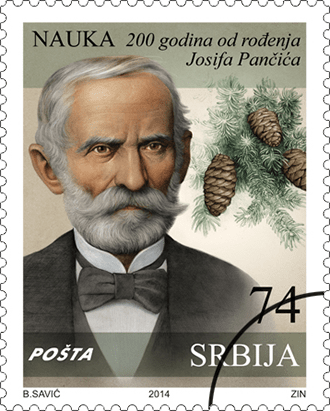





100 years from the birth of Petar Stevanović (1914–1999)
Petar Stevanović, professor of geology at the University of Belgrade, member of the Serbian Academy of Sciences and Arts, president of the Serbian Geological Society, and scientist with high international reputation, is the last student of the prominent Serbian geologist Jovan Žujović.
His career began at the Natural History Museum in Belgrade in 1938, as curator and the head of Geological and paleontological as well as Mineralogical-petrological departments. The period of World War II (1941-1945), he spent imprisoned in the Osnabruck labor camp, Germany. Pedagogical and scientific activities commenced at the Faculty of Philosophy in Belgrade in 1946. He defended his PhD thesis “The Lower Pliocene of Serbia and neighboring areas” at the Moscow Paleontological Institute (USSR) in 1948. He lectured the following subjects: Introduction to independent geological-paleontological investigations, Stratigraphy of Yugoslavia, the Quaternary geology. He was the author of the textbooks: Historical Geology II-the Paleozoic Periods, Historical Geology-the Cenozoic Periods and the Quaternary Geology.
In the field of Neogene stratigraphy of Pannonian Basen, he has introduced the two new substages (time-intervals), the Portaferrian (the Upper Pontian) and the Serbian (the Upper Pannonian) and identified forty taxa, new for science (bivalve and gastropod species and subspecies). During his long-lasting geological field research, he discovered new fossiliferous localities of different geological age in the Belgrade area, Kolubara Basin, Kostolac, Krupanj, Koceljeva, Loznica and Timočka krajina. Good knowledge of several languages (Russian, French, German) enabled him to follow successfully the achievements in geosciences and to participate in many international expert teams and committees. His first scientific article was issued in 1937, and up to 1999. he published more than 200 scientific and professional papers.
He was appointed as a member of the Yugoslav Academy of Sciences and Arts, the Slovenian Academy of Sciences and Arts, and the Academy of Sciences of Bosnia and Herzegovina, as well as the honorary member of the Hungarian Geological Society and the Paleontological Society of the German Federal Republic. His successful and fruitful work has been awarded by several orders and rewards (Order of Labor with the Golden Wreath, two October Prizes of City of Belgrade, “Seventh July Prize”). Owing to the great working capacity and self-discipline, he has achieved excellent scientific outcomes and made significant contributions to: developing and enhancing the geology school and geological education in Serbia, teaching and training of generations of geologists and paleontologists promoting and popularizing the geology and geosciences; developing the museology, and conserving and preserving the geological heritage of Serbia.
Expert cooperation: Aleksandra Maran Stevanović, Museum of Natural History
200 years from the birth of Josif Pančić (Ugrine: 1814 – Belgrade: 1888)
When he decided to take up botany, Pančić never dreamed it would lead him to Serbia, where he would become the most renowned botanist and one of the great men of Serbian science. He fell in love with nature as a child, and his desire to learn as much of it as possible lead him through Gospić, Rijeka and Zagreb to Pest, where he studied and gained his PhD at the Medical Faculty. He came to Serbia in 1846 and stayed forever.
In two of his most significant works, the Flora of the Principality of Serbia (1874) and the Supplement to the Flora of the Principality of Serbia (1884) he listed approximately 68% of the currently known species of Serbian flora. His most important discovery is the omorica (Picea omorika), an endemite and relict conifer unknown to science at the time.
Although he is the most important Serbian botanist and one of the greatest Serbian scientists, Pančić was much more than that. As a medical doctor who spoke several languages (Latin, German, English, French, Italian, Spanish), he was one of the best educated people in Serbia at the time. He is the initiator of naturalist thought and sciences in Serbia because he was the first to undertake complex studies of nature and teach natural sciences and was the professor to the next generation of renowned Serbian naturalists. He wrote natural science textbooks, created professional Serbian language terminology for parts of plants, animal organs and geological phenomena, wrote about the need for careful husbandry over natural resources, wrote the first papers on the fauna of Serbia (printed in Serbia), founded the Jestastvenički [natural sciences] Cabinet, its collection becoming the initial fund of the Museum of Natural History, and founded the first Botanical Garden. He was a renowned and respected public personality: the first president of the Serbian Royal Academy (today the Serbian Academy of Sciences and Arts), six times the rector of the Great School, the first manager of the Botanical Garden, vice-president of the National Assembly, state advisor and Member of Parliament. He was dedicated to improving education and the spread of education and culture. He fought for peace and brotherhood among the Slavic peoples and as a doctor, participated in all the liberation wars fought by the Principality of Serbia at the time. He achieved all this because throughout his life he kept to the belief that “A man with knowledge can be of use to people in many situations, yet ignorance is always harmful to all of society”.
Expert cooperation: Olga Vasić, Museum of Natural History, Belgrade.
Christmas






The entire Christian world celebrates the Nativity of Chirst holidays on 25th December. However, three Orthodox Patriarchates - Jerusalem, Russian and Serbian, count the time according to the Julian calendar, and their believers, due to the difference of 13 days, celebrate Christmas on 7th January. Christmas is considered as one of the most important and joyful Christian holidays, and its message is message of peace and love.
Christmas in Serbia is commemorated three days. This is, above all, a family holiday, marked with numerous ancient traditions. On the eve of Christmas, so-called Badnji Dan (Day before Christmas), Badnjak (an oak-tree yule log) is brought into the house, a vigil lamp is lighted, and straw scattered across the floor, together with some sweets, prunes, walnuts, sugar cubes and coins hidden. The straw is there to symbolise the Nativity scene, the yule log is a symbol of longevity and steadiness of Christianity, and the warmth of love that Christ brings to us by His birth and arrival to the Earth. On the Christmas day, early in the morning, the church bells toll and announce the arrival and birth of Christ. The people go to church to the Christmas Liturgy and greet one another: “Christ is Born!”, answering: “He is truly Born!”.
Motif on the stamp face value 23,00 RSD: “Christmas Anthem” fresco from the Monastery of Žiča, 1309-1316. Motif on the stamp face value 70,00 RSD: the central motif of the “Christmas Anthem” fresco from the Monastery of Žiča – Virgin with Child and notes with the song of Damaskin Grdanički.
Graphic realization of the stamps: MA Jakša Vlahović, academic graphic artist.
Expert collaboration: Museum of the Serbian Orthodox Church, Belgrade, National Museum and Gallery of Frescoes, Belgrade.
70th anniversary of liberation of Belgrade

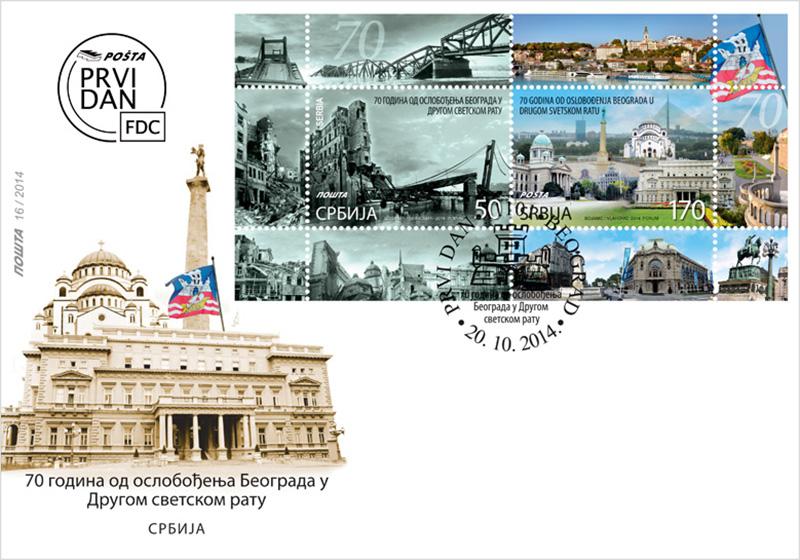
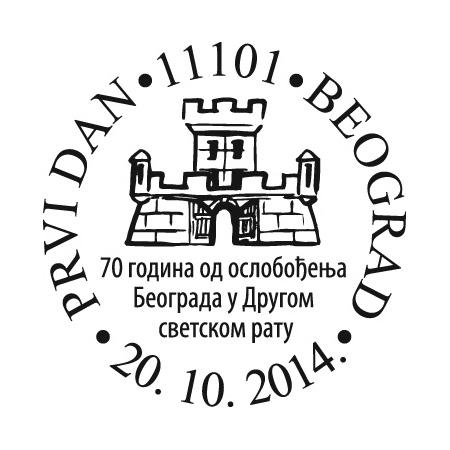
The Battle for liberation of Belgrade or the “Belgrade Offensive” was the biggest and one of the most decisive battles in the Balkans during the Second World War.
Preparing for the Battle, the National Liberation Army of Yugoslavia (NOVJ), supported by the Allies’ aviation, broke all the communications to the German Army Group E departing from Greece, while the parts of the Soviet Third Ukrainian Front of the Red Army entered the territory of Yugoslavia from Bulgaria. The First Army Group of NOVJ took part in the operation under the command of General Peko Dapčević and Fourth Guards Mechanised Corps of the Red Army, under the command of Marshal Vladimir Ivanovich Zhdanov.
The battles in the Belgrade City area were fought from 14th till 22nd October 1944. Belgrade was beseiged from the south and east, and the joint armies fought back using infantry troups, tanks, guns and mortars. Belgrade suffered immense material damages, and the liberation armies paid a tremendous cost in human lives. NOVJ lost around 2,950, while the Red Army had around 960 dead combatants. However, Wehrmacht suffered far more losses in materiel and human lives, with around 17,000 dead.
The battle for liberation of Belgrade contributed considerably to faster end of the War in Europe. The German armies in retreat from Greece and Albania could not use the main communications along the Vardar and Morava rivers any more, but were forced to traverse far worse mountain communications through Sanjak, Bosnia and Dalmatia. That caused slowdown in their movements and increased their losses in material and human forces.
Expert collaboration: Milorad Jovanović, PTT Museum, Belgrade.
Artistic realization of the stamps: Radomir Bojanić, academic painter and Jakša Vlahović, academic graphic artist.
Children’s postage stamp - Fables

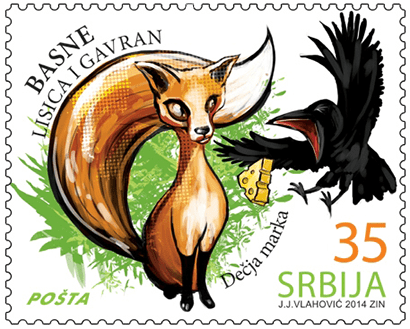
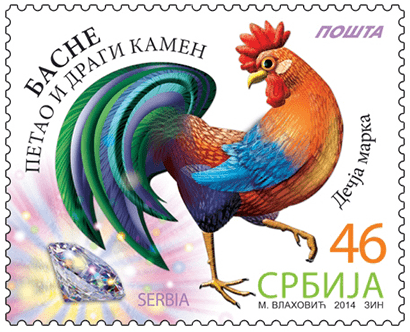



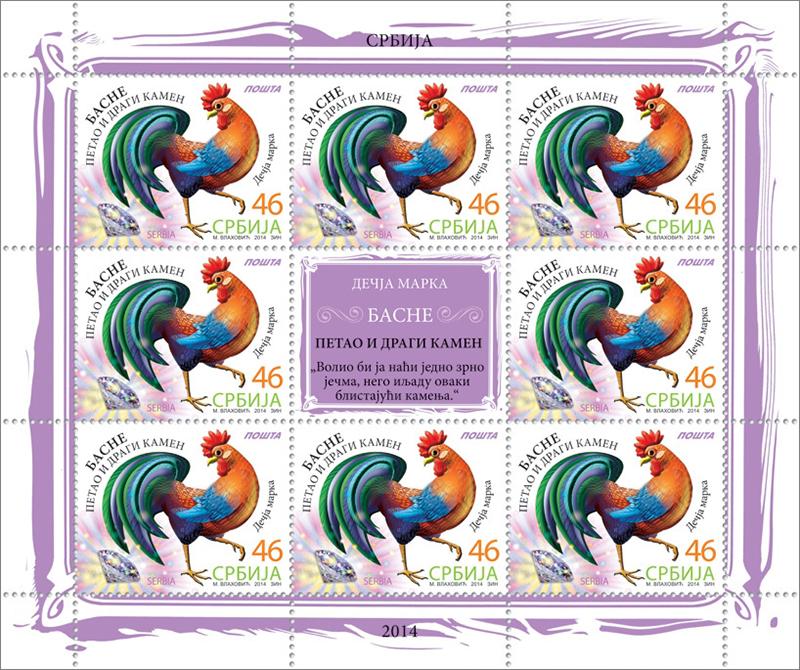




Every year, almost all world postal administrations publish a special postage stamp issue named Children’s postage stamp. The motifs of these stamps are usually the favourite children’s pets and fairy tales and literature heroes, children’s toys, cartoons. Children’s stamps may include educational and corrective topics in animated form, i.e. drawings on certain topics that children normally learn in school: famous scientists and phenomena that they study, historical figures and events, sports heroes, pets and attitude towards them...They are all represented in a way that is interesting and understandable to little children.
The theme of this year’s Children’s postage stamp is the fable - short story in which animals behave like humans. Fables are at the same time instructive stories, narrated concisely and with great humor, and containing important life truths. Dositej Obradović, Serbian educator and fabulist has collected and published the fables that are motifs on stamps.
Motifs on stamps: 23 RSD - The dog and his shadow; 35 RSD - The fox and the crow; 46 RSD - The rooster and the precious stone; 70 RSD - The turtle and the eagle.
Motifs on the envelopes: a - Two mice; b - Pig and oak.
Artistic realization of the stamps: academic graphic artists Jakša Vlahović and Marija Vlahović.
150 Years since the birth of Nikolai Krasnov





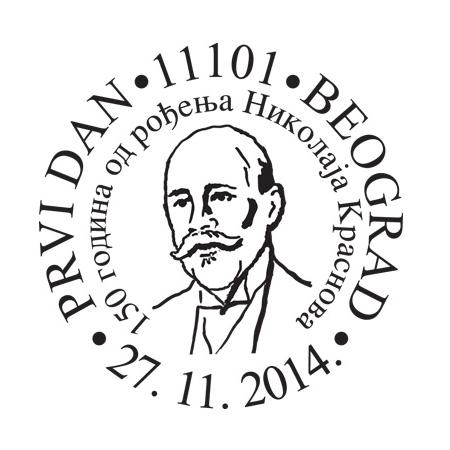
Nikolai Petrovich Krasnov (Moscow, 1864 - Belgrade, 1939) was one of the most important architects whose creations, both in the field of architecture and urban planning, as well as in the field of interior design and applied arts, left a significant mark in the appearance and culture of Belgrade and Serbia between two world wars. He arrived in Belgrade in 1922, after three years of refugee residence in Malta, and got employed in the Ministry of Construction, where he remained until his death in 1939. During those seventeen years, Krasnov has built a large number of representative buildings in Belgrade, without which it would be nowadays almost impossible to imagine the capital city. Included among them is the building of the Government of Serbia and the Ministry of Foreign Affairs, the Archives of Serbia and the Church of Ružica in Kalemegdan park, the extension and remaking of the Ministry of Finance building and the building of the Yugoslav Drama Theatre (formerly „Manjež“), interiors of the National Parliament, the Royal Palace in Dedinje, the coastal bridge pylons of King Alexander’s Bridge (today the Branko’s Bridge)...
Outside Belgrade, he designed and performed the ossuary of Serbian soldiers on the island of Vido, the interior of the chapel in the Serbian military cemetery in Zejtinlik, Thessaloniki, Njegoš chapel and mausoleum on Lovćen, the interior of St. George’s church in Oplenac, Topola, the Governor’s Palace in Cetinje... Even projects that were not implemented, as well as those which primarily belong to the field of applied arts, represent unique and valuable achievements, such as projects for: the Agrarian Bank in Belgrade, the new building of the Ministry of Finance, the reconstruction of the building of the Ministry of Construction in Belgrade, the Hunting Lodge in Petrovčić, the garden pavilion with a reflective pond in the garden of the Royal Palace at Dedinje, a monument and a number of memorials on the road of withdrawal of the Serbian army through Albania, and numerous drafts of realized and unrealized church equipment (iconostasis of the church in Šilopaj, of the church in the military cemetery in Skoplje, of the chapel of Andrew the Apostle in the scope of the Royal Palace at Dedinje...). He also did the draughts for the church linens, the altar equipment, stands, thrones, chandeliers, candelabras, wall lamps, furniture, jewelry, medals and diplomas, funeral decor and even the decoration of the funeral vehicle for the funeral of King Alexander I. The work of Nikola (as he used to sign himself in gratitude to his new country) Krasnov, Serbian and Russian academic, belongs to the top architectural and applied arts achievements, and his productivity is remembered as a phenomenon in its own time. Krasnov was buried in the Russian necropolis at the New Cemetery in Belgrade.
Artistic realization of the stamps: Аnamari Banjac, academic painter and Radomir Bojanić, academic painter.
Expert collaboration: Dragomir Acović, architect.
25 years of diplomatic relations establishment with the Republic of Korea



The Republic of Serbia and the Republic of Korea on 27 December 2014 marks the 25th anniversary of diplomatic relations. Our country was among the first in the Central and Eastern Europe which recognized the positive political changes in South Korea in late 80s of the last century, which led to the establishment of official diplomatic relations.
After the end of the Korean War (1950-53), the Republic of Korea has achieved a remarkable economic and social development. Despite the lack of natural resources and extremely unfavorable international environment, one of the poorest countries in the world has become an industrial and technological giant in the period of only six decades, the 13th world economy and the only country that has turned from the recipient into provider of development assistance to the developing countries. South Korea achieved that by selfless efforts of the citizens and with the development of industries based on modern technologies, construction of infrastructure and huge investments in education. This transformation is therefore often called the “Miracle on the River Han“, after the name of the river that runs through the capital city of Seoul.
With its 50 million inhabitants in the teritory slightly larger than the area of the Republic of Serbia, the Republic of Korea cherishes friendly relations with our county. Total bilateral relations are on the rise, in recent years the Korean companies have opened their representative offices and factories in Serbia, while the world-famous Korean company Samsung, LG and Hyundai-Kia are enjoying a great reputation and the trust of the citizens of our country.
Artistic realization of the souvenir sheet: academic graphic artists Jakša Vlahović and Marija Vlahović. Professional cooperation: the Ministry of Foreign Affairs of the Government of the Republic of Serbia.
100 years since the birth of Ljubica Cuca Sokić



Ljubica Cuca Sokić (9. 12. 1914 – 8. 01. 2009) is a famous Serbian painter, professor of Belgrade University and an academic. She marked Serbian and Yugoslavian art of the 20th century with her personality and work, and she is a real representative of Serbian intimistic painting. She was a painter of a plain and simple life, weather she was painting interior, still life, or she was devoted to painting landscapes, figures or portraits. Later in his work she moved to simplifying forms, geometrics and moderate abstraction, which lead her to reducing the painting to refined relation between painted surfaces: gray, blue, green and brown. Since 1961 Ljubica Sokić worked with pastel colours. At times she used collage and experimental materials techniques. Besides painting, she illustrated children’s books and magazines, and also made sketches for movies. As for many of our intimistic painters, schooling in Paris, in the second half of thirties, for Cuca Sokić was crucial.
French art and French cultural milieu determined the course and spirit of Belgrade painting school, whose one of the most prominent representatives was Cuca Sokić. Her painting was elegiac, lyric and intimate, at first sight simple, and in fact very layered. Београдске сликарске школе, чији је један од најистакнутијих представника била Цуца Сокић. Њено сликарство је било елегично, лирско и интимно, на први поглед једноставно, а у суштини веома слојевито.
Cuca Sokić comes frоm a rich civil family. She was educated, and respected not only as a great painter, but also as a person of high moral beliefs. Everyone who knew her emphasized her civic education, human dignity, modesty and honesty. Department of Fine Arts of the Serbian Academy of Sciences and Arts, whose member was Cuca Sokić, started the initiative to name one of the streets in Belgrade by the name of this famous painter.
Artistic realization of the stamp: MA Marina Kalezić, academic painter.
Expert collaboration: Serbian Academy of Sciences and Arts.